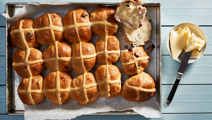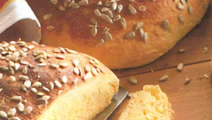Bread plait

This bread plait recipe is a delightful addition to your Easter table. It is a stunning and deliciously tender loaf truly perfect for the occasion. Made with simple, wholesome ingredients, it combines the soft, juicy crumb of traditional bread with a lightly crunchy topping of pearl sugar and almond flakes. Serve it fresh and warm, slathered with butter, to capture the essence of homemade joy and festivity.
Ingredients
Dough
|
Butter or spreadable
|
125 g |
|---|---|
|
Arla Cravendale Whole milk
|
250 ml |
|
Yeast
|
25 g |
|
Egg
|
1 |
|
Wheat flour
|
500 g |
|
Sugar
|
2 tbsp |
|
Salt
|
1 tsp |
Garnish
|
Beaten eggs
|
|
|---|---|
|
Swedish pearl sugar
|
|
|
Almond flakes
|
Instructions
Recommended information
Serving suggestion
Tips
The key to a good bread plait lies in the consistency of the dough. It should be soft, slightly sticky, but manageable. After combining the ingredients, knead the dough until it becomes smooth and pliable. If the dough sticks excessively to your hands, add more flour, but do so sparingly. Too much flour can make the bread dense and heavy. The ideal dough should pull away from the sides of the bowl but still feel tacky to the touch.
Tips
Freshly baked plaited bread is a joy like no other, but it does not last forever. Ideally, the bread should be eaten within two to three days for the best texture and flavour. Store the bread in a bread box or wrap it in a clean, dry cloth inside a plastic bag to keep it from drying out.
Tips
You can also freeze the bread to extend the shelf life. Once cooled, wrap the loaf tightly in cling film, then a layer of foil, or place it in a freezer bag. When stored properly, the bread can last in the freezer for up to three months. When you are ready to enjoy it, thaw the bread at room temperature.
Make a plaited bread for your Easter table
Easter calls for something special on the dining table, and what could be more fitting than a beautifully plaited bread? Not only is it impressive to look at, but it is also deceptively easy to make. Using just a few humble ingredients like flour, butter, yeast, egg, and milk you can create a loaf that is both stunning and delicious. With a golden crust and soft, fluffy interior, it is the perfect centrepiece for your Easter table. The beauty of this bread lies not only in its simplicity but also in the joy it brings when making and eating it.
A juicy crumb sprinkled with a little crunch
The appeal of this freshly baked plaited bread extends far beyond its looks. As you slice into the loaf, you are greeted with a juicy, tender crumb perfectly balanced by a sprinkle of Swedish pearl sugar and almond flakes. The contrast between the soft interior and the beautifully golden crust, enriched with a light crunch, makes each bite delightful. It is truly a testament to how simple ingredients can result in an extraordinary dish.
How to plait a bread
Plaiting bread might seem daunting at first, but with a bit of guidance, it is quite straightforward. After preparing your dough, divide and roll it into three long strands. The plaiting process is similar to braiding hair: cross the right strand over the centre one, then the left, and alternate until you reach the end, ensuring that each strand passes over the middle one. It is important to pinch the ends well together to prevent them from unravelling during baking. This technique creates a beautiful pattern on the loaf and ensures that it bakes evenly. Remember, the key to a beautiful plait is patience and practice. So, do not let a few imperfections discourage you.
Serve warm with butter
There is something very comforting about serving warm, freshly baked bread. The plaited loaf is best enjoyed sliced and slathered with a generous layer of butter. The butter melts into the soft, warm crumb, creating a rich, indulgent mouthfeel. But you can also just tear off a piece and pass it around the table. This bread invites you to savour the moment and enjoy the simple pleasure of homemade baking. Whether enjoyed as part of your Easter table or as an accompaniment to the holiday meal, this bread plait is sure to be a hit. In need of more delicious treats for your Easter table? Try our recipes for Iced Easter biscuits or cheerful Easter cake pops. If you prefer something a bit more fruity, we suggest you go with these blueberry cheesecake muffins.
Add your own touch
While the bread plait recipe is quite basic, there are numerous ways to add a personal touch and make it truly yours. Experimenting with spices, such as cinnamon, cardamom, or nutmeg, can infuse the loaf with warm, aromatic flavours, perfect for any festive occasion. You can also alter the topping by using different seeds, nuts, or even a glaze that can add new textures and flavours. For those feeling a bit more adventurous, plaiting the bread with more than three strands can create intricate patterns that are sure to impress your guests. These personal touches not only enhance the flavour and appearance of the bread but also make the baking experience even more enjoyable.








